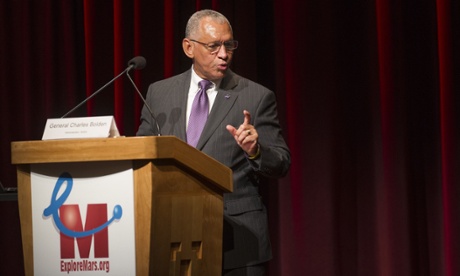

| Visitors Now: | |
| Total Visits: | |
| Total Stories: |

| Story Views | |
| Now: | |
| Last Hour: | |
| Last 24 Hours: | |
| Total: | |
Nasa Chief Bolden Says Agency Can Go Where No Man Has Gone Before: Mars
Monday, May 6, 2013 17:31
% of readers think this story is Fact. Add your two cents.
Nasa Chief Bolden Says Agency Can Go Where no Man has Gone Before: Mars
Sequester cuts and ‘technology gaps’ cannot quell agency’s confidence and interest from aspiring astronauts
If the prospect of spending a thousand days up to 140 million miles away from the Earth was not enough of a deterrent, killer radiation levels and enforced radio silence would surely deter most volunteers from travelling to Mars.
Nasa, however, has revealed that near-record numbers are applying for its astronaut training programme, as renewed enthusiasm for space travel is fueled by growing hopes of a manned Mars mission.

A scientist participates in a joint Austrian-Moroccan simulation of a mission to Mars. Nasa says it is close to achieving the real thing. Photograph: Handout/Reuters
Since the successful landing of the Curiosity rover in August, the scientific community has begun to take more seriously a promise from President Obama, made in 2010, to land humans on the surface of Mars within 20 years or so.
Some privately-backed rival ventures are even forecasting that they will get to Mars orbit as early as 2018; Nasa plans a deep-space practice mission, to rendezvous with a captured asteroid, by 2025.
“Interest in sending humans to Mars has never been higher,” Nasa’s chief administrator, the former astronaut Charles Bolden, told a conference in Washington on Monday.
“‘We now stand on the precipice of a second opportunity to press forward with what I think is man’s destiny, and that is to go forward to another planet.”
Within the next few weeks, Nasa plans to announce which 20 trainee astronauts it has chosen from 6,300 recent candidates – its second-highest application total since the agency was established, in 1958.
“These astronauts will be among the first trained specifically for long-duration space flights,” said Bolden.

Nasa administrator Charles Bolden speaks at the Human 2 Mars Summit at George Washington University. Photograph: Jim Watson/AFP/Getty Images
Despite sweeping US budget cuts under the sequestration, Nasa still hopes for an annual budget of $17.7bn – which will be increasingly targeted on the Mars mission.
The agency is seeking congressional approval to outsource to private contractors all future rocket missions to low earth orbit, so it can concentrate on deep space instead.
But the three-day conference in Washington has also revealed the significance of the remaining “technology gaps”.
The one-ton Curiosity rover was lowered on to the surface of Mars from a spacecraft acting at current weight limits as a “sky crane” – engineers estimate a human-carrying capsule would need to weigh at least 40 times as much.
Nasa also needs to invent giant new solar panels – powerful enough to complete a round trip to Mars but flexible enough to fold up into a rocket – and find ways of preventing charged ions from corroding the propulsion nozzle.
By Dan Roberts in Washington
The Guardian
READ MORE:


